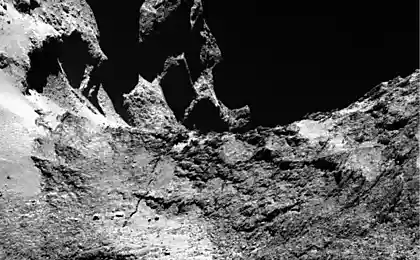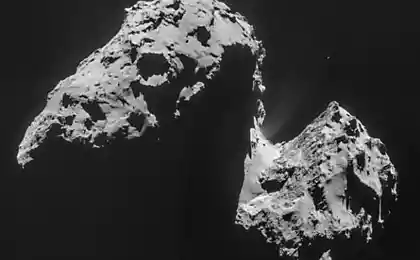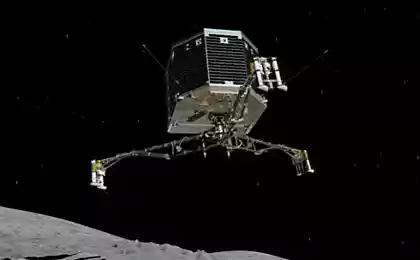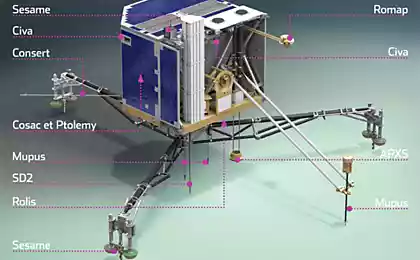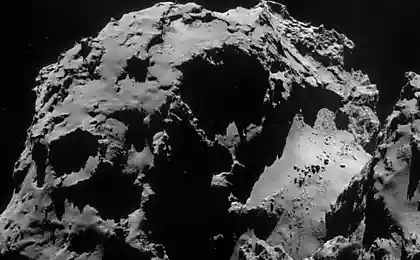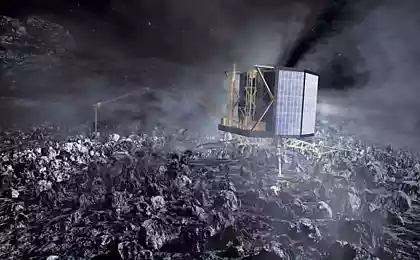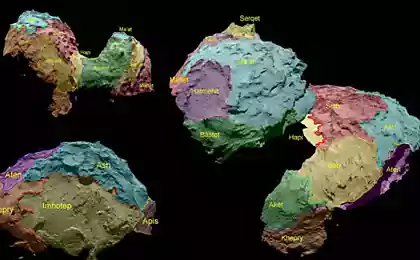508
Rosetta Mission: The end is near
30 September interplanetary station will be put on the surface of the comet Churyumov-Gerasimenko

Still from the animated film Rosetta and Philae
Last year, representatives of the project team interplanetary probe Rosetta made a bold proposal: to put the unit on a comet, completing thus the duration of the mission in 12 years. Earlier it was planned just to turn off the station to the project team could pursue other projects. But now Rosetta in the case of a successful landing can be a time to continue their work by studying the comet. Why do I have to close the project? Because the station is permanently removed from the earth and the sun. Rosetta Solar batteries are becoming less energy, it will soon prove to be insufficient for normal operation of the spacecraft. In addition, the thinner and the thread that connects the Rosetta and Earth - it's about the link. Channel capacity all the time is reduced for the same reason - the station is removed from the Earth.
Rosetta spent in space for about 12 years. 2, the station studied the comet Churyumov-Gerasimenko. At this stage, the most important task was to land on the surface of the object probe Philae. The machine sat on a comet, but it all went a bit off-plan - Philae bounced landing, flying a few hundred meters and finally stopped after the fourth shock. In this Philae stuck in the crack, which reached a depth of several meters. Despite all these problems experts managed to use scientific instruments functioning of the probe, and the research program was carried out by 80% in just 64 hours.
As part of this program was able to verify the hardness of the surface of the comet (as expected, the comet is quite loose, the main surface of the components - is ice and dust). It is also able to measure the temperature of the surface, photograph it, to analyze the composition of gases and dust. On the comet Churyumov-Gerasimenko appeared a large number of organic compounds, and quite complex. Among the most common - formaldehyde, methyl isocyanate, acetamide, and other substances.
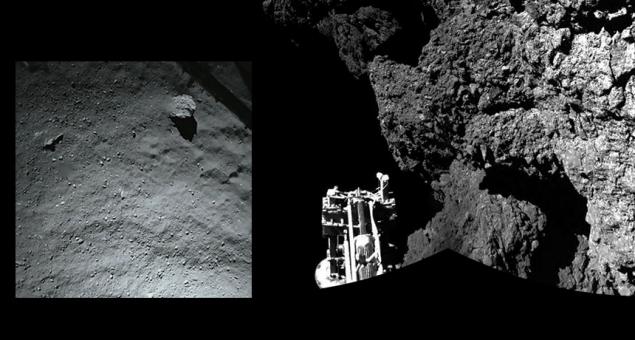
After 64 hours the probe went into hibernation. Scientists believe that as you get closer to the Sun, the comet probe will be getting more and more energy, allowing him to return to work. In June last year, what happened, and the unit was able to respond to the signals of the Earth, using Rosetta as a repeater. However, the communication sessions were fragmented. The first lasted 78 seconds, the second - for 4 minutes, and the third - 19 minutes. During this time, it managed to take all of the telemetry data, due to the fact that the connection was not very good. But what got earth scientists helped to understand what happened with the device. After this Philae silent, although a month later with it still managed to be contacted again. Within 17 minutes, the probe was maintained communication, telemetry and everything was loaded.
But after that communication attempts had to be stopped due to the fact that Rosetta had to change the trajectory of motion - research involves the study of the other part of the comet. Contact with the probe could not be there, and Philae silent forever.
Now came the silence and for Rosetta, as if a scientist might wish to extend the life of the unit. The last moments of life vehicle will not be meaningless - the station will work till the last, conducting measurements of various parameters of the comet, photographing the surface in high resolution and performing other tasks. All this time will be transmitted to Earth. As Rosetta reduce communication channel will be available, but after the unit falls onto the surface of the comet Churyumov-Gerasimenko, all operations will stop.
"We will try to accommodate the maximum number of tasks at this time, so much, as far as possible to the moment when the input of solar energy. 30 September - this is the end of all operations, but the "beginning of the end" will allow us to obtain a large amount of scientific information. That's what Rosetta was launched in space, and we have been working for several years, carefully analyzing the data of the mission, "- says Matt Taylor, Senior Scientist Project Rosetta.
machine operators will change its trajectory in August, with the release of a series of elliptical orbits, the latter of which will allow the unit to get closer to the comet at the minimum distance and sit on the surface of the object. Experts say that the final phase of planning is more complicated than landing Philae. The last six weeks, during which time Rosetta will carry out maneuvers are much more difficult for scientists than the actual landing. The fact that at least closer to the comet Churyumov-Gerasimenko it will have an increasing influence on the machine. This will require scientists particularly careful observation of the orbit of the station, with her holding the given parameters.
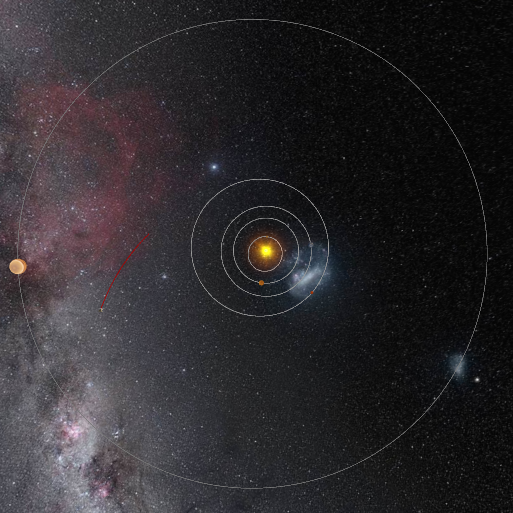
Where the comet will be September 30?
It remains only to wish good luck to the scientists, and the station itself - sit down so gently that many years later, perhaps - century, the Rosetta could be removed from the comet and set in any interstellar space exploration history museum
. Source: geektimes.ru/post/278000/

Still from the animated film Rosetta and Philae
Last year, representatives of the project team interplanetary probe Rosetta made a bold proposal: to put the unit on a comet, completing thus the duration of the mission in 12 years. Earlier it was planned just to turn off the station to the project team could pursue other projects. But now Rosetta in the case of a successful landing can be a time to continue their work by studying the comet. Why do I have to close the project? Because the station is permanently removed from the earth and the sun. Rosetta Solar batteries are becoming less energy, it will soon prove to be insufficient for normal operation of the spacecraft. In addition, the thinner and the thread that connects the Rosetta and Earth - it's about the link. Channel capacity all the time is reduced for the same reason - the station is removed from the Earth.
Rosetta spent in space for about 12 years. 2, the station studied the comet Churyumov-Gerasimenko. At this stage, the most important task was to land on the surface of the object probe Philae. The machine sat on a comet, but it all went a bit off-plan - Philae bounced landing, flying a few hundred meters and finally stopped after the fourth shock. In this Philae stuck in the crack, which reached a depth of several meters. Despite all these problems experts managed to use scientific instruments functioning of the probe, and the research program was carried out by 80% in just 64 hours.
As part of this program was able to verify the hardness of the surface of the comet (as expected, the comet is quite loose, the main surface of the components - is ice and dust). It is also able to measure the temperature of the surface, photograph it, to analyze the composition of gases and dust. On the comet Churyumov-Gerasimenko appeared a large number of organic compounds, and quite complex. Among the most common - formaldehyde, methyl isocyanate, acetamide, and other substances.

After 64 hours the probe went into hibernation. Scientists believe that as you get closer to the Sun, the comet probe will be getting more and more energy, allowing him to return to work. In June last year, what happened, and the unit was able to respond to the signals of the Earth, using Rosetta as a repeater. However, the communication sessions were fragmented. The first lasted 78 seconds, the second - for 4 minutes, and the third - 19 minutes. During this time, it managed to take all of the telemetry data, due to the fact that the connection was not very good. But what got earth scientists helped to understand what happened with the device. After this Philae silent, although a month later with it still managed to be contacted again. Within 17 minutes, the probe was maintained communication, telemetry and everything was loaded.
But after that communication attempts had to be stopped due to the fact that Rosetta had to change the trajectory of motion - research involves the study of the other part of the comet. Contact with the probe could not be there, and Philae silent forever.
Now came the silence and for Rosetta, as if a scientist might wish to extend the life of the unit. The last moments of life vehicle will not be meaningless - the station will work till the last, conducting measurements of various parameters of the comet, photographing the surface in high resolution and performing other tasks. All this time will be transmitted to Earth. As Rosetta reduce communication channel will be available, but after the unit falls onto the surface of the comet Churyumov-Gerasimenko, all operations will stop.
"We will try to accommodate the maximum number of tasks at this time, so much, as far as possible to the moment when the input of solar energy. 30 September - this is the end of all operations, but the "beginning of the end" will allow us to obtain a large amount of scientific information. That's what Rosetta was launched in space, and we have been working for several years, carefully analyzing the data of the mission, "- says Matt Taylor, Senior Scientist Project Rosetta.
machine operators will change its trajectory in August, with the release of a series of elliptical orbits, the latter of which will allow the unit to get closer to the comet at the minimum distance and sit on the surface of the object. Experts say that the final phase of planning is more complicated than landing Philae. The last six weeks, during which time Rosetta will carry out maneuvers are much more difficult for scientists than the actual landing. The fact that at least closer to the comet Churyumov-Gerasimenko it will have an increasing influence on the machine. This will require scientists particularly careful observation of the orbit of the station, with her holding the given parameters.

Where the comet will be September 30?
It remains only to wish good luck to the scientists, and the station itself - sit down so gently that many years later, perhaps - century, the Rosetta could be removed from the comet and set in any interstellar space exploration history museum
. Source: geektimes.ru/post/278000/





